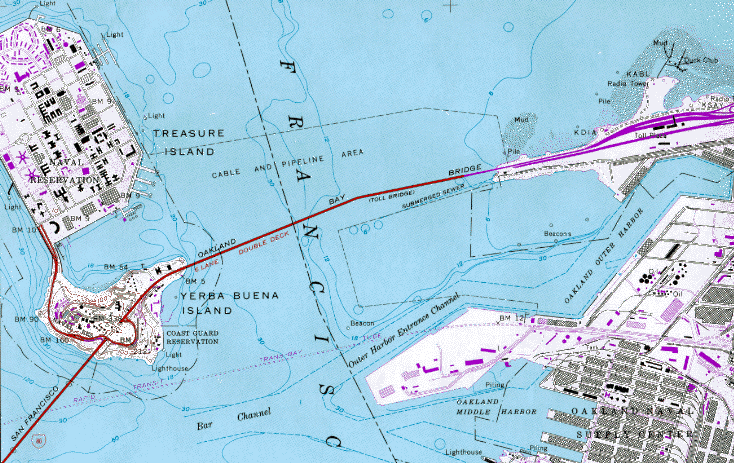and a discussion of different proposed alignments for a new bridge
north
<—west................................................................................................................east—>

north
<—west................................................................................................................east—>

The proposed new span would run to the north of the present bridge along a path called the northern alignment. Several possible alignments were publicly mentioned and shown in official documents. Only one of them, a proposed alignment which would extend from the Yerba Buena tunnel in a northeasterly direction, curve and change direction before heading toward Oakland on a southeasterly course, was recommended by the Engineering and Design Advisory Panel (EDAP) and subsequently approved by the Metropolitan Transportation Commission.
Dr. Abolhassan Astaneh of U.C. Berkeley pointed out, in the spring of 1997, that an underwater canyon, a river bed during the last ice age, was located directly under this “preferred” alignment. This fact was published in 1930s geological surveys but was overlooked as MTC rushed to approve the proposed design and alignment. A bridge built over the canyon would be vulnerable to underwater mudslides, with risk of damage or even total collapse, particularly in an earthquake. Confirmation of this by the State of California’s Department of Transportation (Caltrans) led to a rejection of EDAP’s preferred far northern alignment. A compromise brought the alignment about 1000 feet further south, but still well north of the present bridge. This less extreme northern alignment necessitated shortening the proposed “long-span” segment of the bridge with the result that its central suspension tower would be right in the middle of a little-used shipping lane which the suspension structure was supposed to have spanned. This, in turn, led to the self-anchored suspension structure’s radical asymmetry, unlike that of any suspension bridge in the world, which in turn causes it to be statically unbalanced. This leads directly to the proposed suspension structure’s serious seismic deficiencies, and to grave ethical concerns.
Southern alignment
A southern alignment—south of the existing bridge—is preferred by the City of San Francisco and the US Navy. Caltrans has also supported a straight, southern alignment, though EDAP, in recommending its own crooked northerly bridge proposals, effectively eliminated a southern alignment from contention in the MTC process. A southern alignment would best avoid interfering with both the Navy's historical site on Yerba Buena Island and San Francisco's planned development of Treasure Island. The Metropolitan Transportation Commisssion (MTC) Bay Bridge Task Force Chair has ridiculed these considerations as trivial compared to seismic safety concerns. (That is, the replacement bridge needs to be expedited.) However, federal law does mandate consideration of development plans and historic sites in major bridge projects. Early consideration is meant to ensure that a major project does not create controversy and conflict. Rational planning which takes into consideration political, social, transportation and environmental needs is supposed to avoid delay and in this case most likely would have done so. In this project the only thorough considerations have been the awarding of public contracts through Caltrans for designing a bridge which won't be built (T.Y. Lin International and affiliated companies), the writing of sub-mediocre environmental studies (URS/Woodward-Clyde) and denial of responsibility for any part in the resulting political controversy, planning chaos, and resulting delays which put the public at risk.
A study by a private engineering firm commissioned by the City of San Francisco considered the southern alignment, designated S-1, as feasible and preferable. The Caltrans project manager has stated his preferance for this alignment. The S-1 alignment, a straight southern route, would be the shortest distance between two points. It would consequently be the most economical, even with the preposterous allowance of $100 million for moving a sewer pipe. The S-1 would drastically diminish political opposition, and would make way for designs which would accommodate rail, bicycle and other transit options. A straight bridge would also avoid (1) the structural difficulties associated with curved bridges; (2) the inordinately complex task of predicting the seismic behavior of twin parallel curved structures; and (3) the unnecessarily dangerous task of appending a steel self-anchored suspension structure, inherently unstable in concept, to a concrete viaduct which has radically distinct characteristics.
.